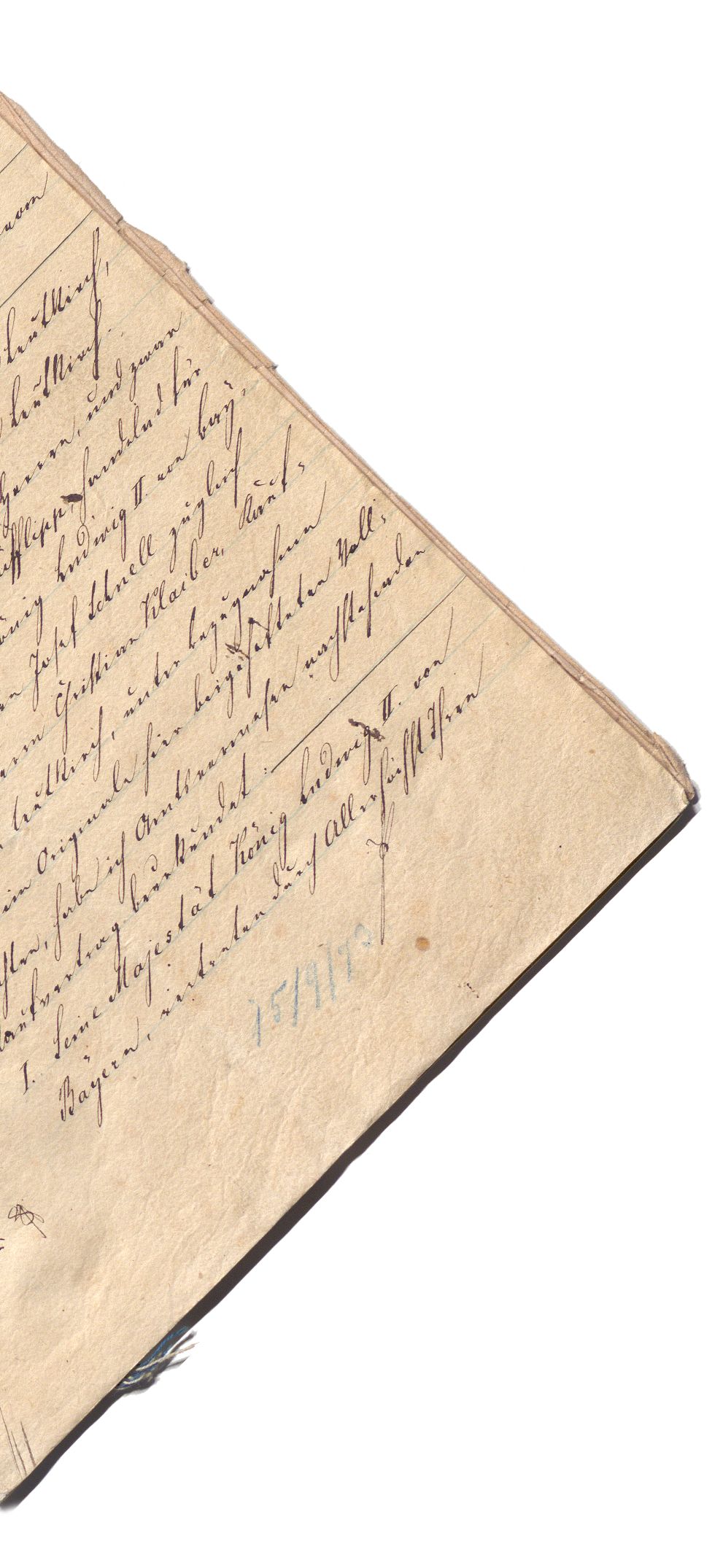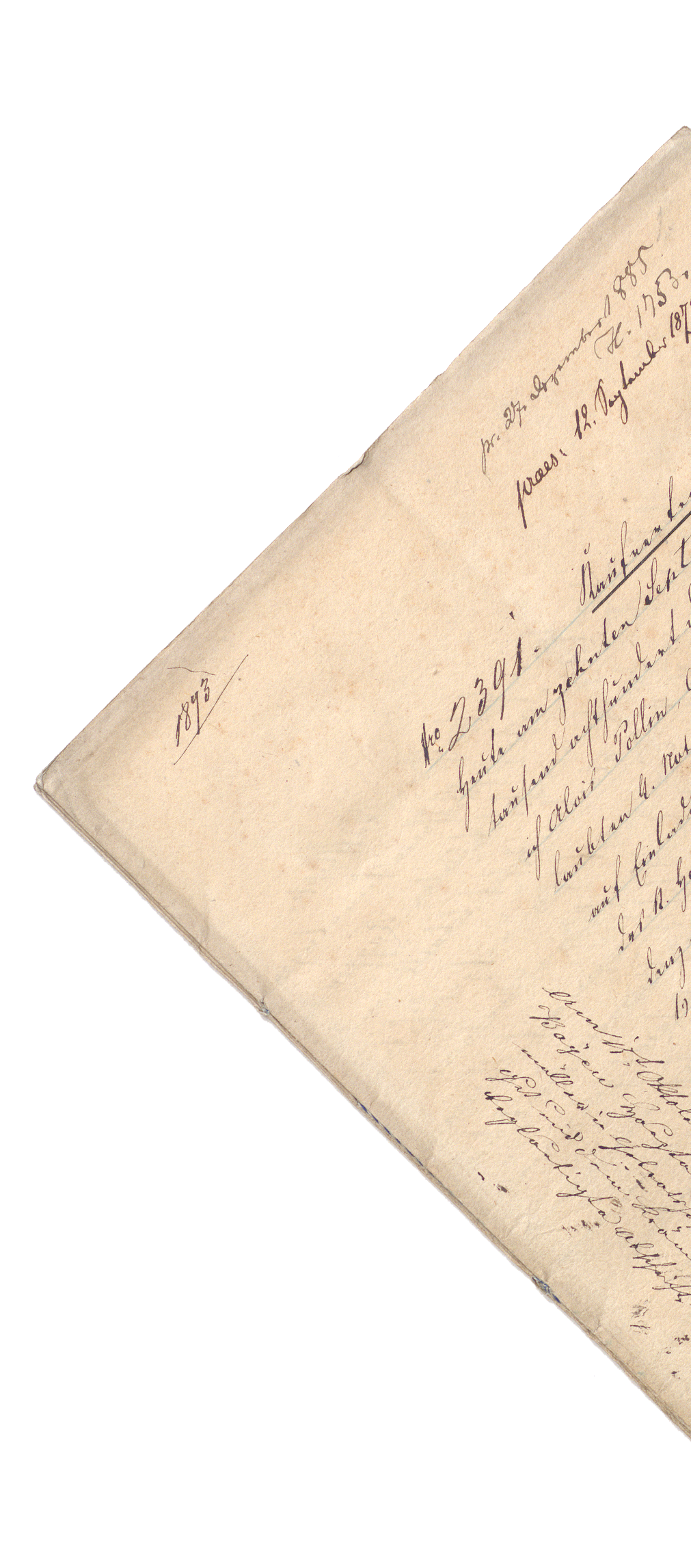
1873 - Sales contract - Purchase of Herreninsel Island by King Ludwig II of Bavaria
King Ludwig II of Bavaria (* 25 August 1845 in Nymphenburg Castle, + 13 June 1886 at Lake Starnberg)
King Ludwig II mainly grew up at Hohenschwangau Castle near Füssen. At the age of 16, Ludwig became aware of Richard Wagner’s operas for the first time. They left a deep and lifelong impression on him. He succeeded to the throne at the age of 18 after his father’s death. His main focus was on the promotion of music and culture. Indeed, Ludwig took his governmental affairs very seriously, but had little interest in military matters. He was more interested in art, architectural projects and technical innovations and had a strong tendency to romanticism. Nevertheless, he had to wage two wars (in 1866 and 1870/71), less for political reasons, but rather because of social pressure.
Ludwig II increasingly withdrew from public life and was barely seen during the daytime. Instead, he preferred going for a walk by night and was thus called “Moon King”. It was only because of the construction of his castles (Neuschwanstein Castle, Linderhof Castle and Herrenchiemsee Castle) that he still took an interest in the outside world, but as he spent all his royal revenues and got highly indebted, his castles could never be completed. That is why, in 1886, his ministries declared him insane. Afterwards, Ludwig was transported to Berg Castle on the shores of Lake Starnberg, where he drowned under mysterious circumstances together with Dr Bernhard von Gudden on 13 June 1886.The notarial act
Munich, 10 September 1873 (sales contract)Herreninsel (also known as Herrenwörth), with a total area of 238 hectares, is the largest of the three main islands on Lake Chiemsee. Until secularisation in 1803, the island was owned by the Convent of Herrenchiemsee. After the dissolution of the Diocese of Lake Chiemsee in 1808, the island was in changing ownership. In 1870, the trees on the island were almost completely cleared by a wood producer of Baden-Württemberg, who owned the island for a short time. Fortunately, Ludwig II purchased Herrenchiemsee Island for 350,000 florins in 1873 and saved the forest. The idea of building a castle on the island emerged only in 1874/75, when the construction plans of Meicost Ettal, or Tmeicos Ettal, a residential palace following the model of Versailles, became more and more extensive, so that the surface of the planned building site in Graswang Valley became too small. Thus, Ludwig relocated his “Versailles” to Herreninsel on Lake Chiemsee.
Ludwig himself was not present to sign the sales contract before notary Karl Hacker in Munich, but empowered his court secretary Lorenz von Düfflipp to complete the legal transaction. Therefore, the power of attorney signed by the king himself is attached to the notarial act.StAM (EIH) notarial office Munich III, register number 2391/1873
Original, paper, stapled, 33 x 22 cm1903 - Adoption act - Wilhelm Conrad Röntgen (discoverer of X-rays)
Wilhelm Conrad Röntgen (* 27 March 1845 in Lennep near Remscheid, Rhineland, + 10 February 1923 in Munich)
Discoverer of X-rays, Wilhelm Conrad Röntgen was born on 27 March 1845 in Rhineland as the son of a cloth manufacturer. In 1848, his family moved to the Netherlands, where Wilhelm’s mother was born. He spent his childhood and youth in Apeldoom. After having completed technical school in Utrecht, he first studied engineering sciences and then physics in Zurich. His scientific activities took him to Würzburg, Strasbourg, Hohenheim near Stuttgart and Giessen. In 1888, he finally obtained the physics chair at the University of Würzburg, where he discovered the famous X-rays, nowadays known as Röntgen rays. One of his very first pictures using X-rays was of his wife’s hand. For this breakthrough medical achievement, he received several awards and, last but not least, the first Nobel Prize in physics in 1901. From 1900 to his emeritus status, Röntgen was professor at the University of Munich. He died in 1923, four years after his wife’s death, in Munich. In accordance with his last will, he found his final resting place in the old cemetery of Giessen, where his parents were also buried.
The notarial act
Munich, 23 February 1903 (adoption act)In January 1872, Röntgen married Anna Bertha Ludwig, daughter of an innkeeper from Zurich. The marriage remained childless, but on 23 February 1903, the couple decided to adopt Josephina Bertha Ludwig, Anna Bertha’s niece, who had lived in the house of the Röntgen family since 1887 and, since then, had been raised by the couple. Josephina Ludwig was adopted at the age of 21. It was decided that her new name “Röntgen” was to be added to her former family name “Ludwig” and that she was excluded from legal succession. Nevertheless, Röntgen and his wife named their adopted daughter in their will as heir, alongside friends, household servants, charitable institutions and the city of Lennep.
StAM (EIH) notarial office Munich II, register number 1903/770 (K 2592)
Original, paper, stapled, 33 x 22 cm1943 - Georg Franz Josef Luitpold Maria of Bavaria – the last will
Georg Franz Josef Luitpold Maria of Bavaria (* 2 April 1880 in Munich, 31 May 1943 in Rome)
In 1897, Georg of Bavaria, grandson of the Emperor Franz Joseph of Austria, entered the Bavarian army as a Lieutenant assigned to the Infantry Lifeguards Regiment and promoted to the rank of Major. During World War I, Georg of Bavaria fought both on the Western Front and on the Eastern Front. He was awarded the Iron Cross, other décorations and the rank of colonel. In 1919, Georg of Bavaria began studying theology in Innsbruck and was ordained Catholic Priest on 21 March 1921. Afterwards, he received a doctorate in canon law. He continued his religious studies in Rome and graduated in 1925 from the Pontifical Ecclesiastical Academy. In Vatican City, he was appointed a protonotary apostolic. Throughout his time in Rome, Prince George lived at Villa San Francesco with the Franciscan Brothers of Waldbreitbach, who dedicated themselves to caring for the sick.
The last will
Georg of Bavaria died at the age of 63 in Rome and was buried in the German cemetery Campo Santo Teutonico. It is said that he died of tuberculosis contracted while caring for the sick.
In his last will, he left money for new bronze gates of St. Peter’s Basilica. His donation also financed the famous art works “Death Gate” built by the sculptor Giacomo Manzù and “The Door of the Sacraments” built by the sculptor Venanzo Crocetti.StAM AG notarial office Munich, register number 1943/4678
Original, paper, 33 x 22 cm


